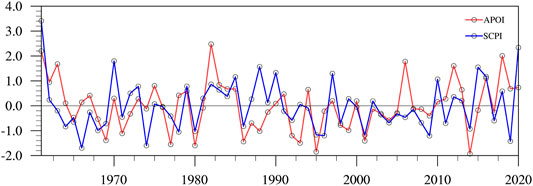- 1School of Atmospheric Sciences, Chengdu University of Information Technology, Chengdu, China
- 2Plateau Atmosphere and Environment Key Laboratory of Sichuan Province, Chengdu, China
- 3Meteorological Disaster Prediction and Warning Engineering Laboratory of Sichuan Province, Chengdu, China
- 4Chengdu Plain Urban Meteorology and Environment Observation and Research Station of Sichuan Province, Chengdu, China
Understanding the spatiotemporal variation of autumn precipitation and its relationship with the large-scale circulation is important for planning industrial and agricultural production, economic development, and ecological protection. This study investigated the relationship between the August Asian–Pacific Oscillation (APO) and September precipitation over Southeast China (SC) during the period 1961–2020. Results showed that the August APO can exert considerable control on September precipitation over SC and that a significant positive correlation exists between them. With a strong (weak) August APO, the anomalous southerly (northerly) winds are observed in the north (south) of SC at the upper level, and the deep trough over East Asia and ridge over North Pacific at 500hPa are both reinforced (weakened). This leads to anomalous northward (southward) lower-tropospheric winds over the East Asian coast, accompanied by enhanced convergence (divergence) of warm and cold air masses and anomalous ascent (descent) motion which results in more (less) precipitation over SC. The underlying mechanism can be explained as thermal anomalies induced by the APO that can persist from August to September, which modulates the atmospheric circulation anomalies in September and eventually causes more (less) precipitation over SC. Therefore, in addition to the role of sea surface temperature forcing on precipitation variations, our analyses suggest that the preceding temperature anomalies at the middle and upper troposphere also should be considered as an important precursory factor for the following precipitation over SC.
Introduction
In China, September is considered the period in which the atmospheric circulation of summer gradually transitions into that of winter, and it is usually a period of abundant precipitation, accounting for more than 50% of the total autumn precipitation over China (Yang and Chen, 2021). Previous studies revealed that anomalies in autumn precipitation have substantial impacts on agricultural production, economic development, and the daily life of the population (Niu and Li, 2008; Barriopedro et al., 2012; Qiang Zhang et al., 2013; Li et al., 2015; Zhang et al., 2016), particularly in Southeast China (SC), which is recognized as the most developed region in the country. Revealing the underlying physical mechanisms of autumn precipitation, especially those affecting the variability of September precipitation over SC, could help improve seasonal climate prediction and water resource management.
Previous studies showed that autumn precipitation in China is highly variable and controlled by low-latitude atmospheric circulations, for instance, the El Niño–Southern Oscillation (ENSO) (Wenjun Zhang et al., 2013; Wenjun Zhang et al., 2014), western Pacific subtropical high (Niu and Li, 2008), and Indian sea surface temperature (SST) (Niu and Li, 2008; Xiao et al., 2015). Some studies also suggested that climatic factors over mid-high latitudes such as the North Atlantic Oscillation (Xu et al., 2013), Silk Road pattern (Hu et al., 2020; Liu and Zhou, 2021), and southern hemispheric sea ice (Zhou et al., 2021) could directly influence autumn precipitation by modulating the Asian monsoon circulation. Although these earlier studies revealed that multiple factors could better explain the mechanism of autumn precipitation anomalies over SC to a certain extent, the underlying mechanism responsible for such variability remains unclear because the influencing factors are complex and vary on a wide range of temporal and spatial scales. Thus, for a more precise and deeper understanding of the causes of the September precipitation variability over SC, it is necessary to investigate other potential controlling factors.
The Asian–Pacific Oscillation (APO), characterized by a dipole mode of summer tropospheric eddy temperatures over the Asian–North Pacific region, was proposed by Zhao et al. (2007). During summer, when the mid-upper troposphere is warmer over Asia, the troposphere above the North Pacific will be colder, and vice versa. The APO can exert substantial impacts on regional–global climatic change via the monsoon circulations and precipitation (Zhao et al., 2007, 2012a; Zhou et al., 2009; Zhou and Zhao, 2010; Liu et al., 2011; Zou et al., 2015; Hua et al., 2019; Lin et al., 2019, 2021), tropical cyclone activity (Zhou et al., 2008; Zou and Zhao, 2010), and variations in SST (Zhao et al., 2010, 2011, 2012b; Zhou et al., 2010). Furthermore, the APO occurs throughout the year, not just in the summertime (Zhou and Zhao, 2010; Lin et al., 2019). In light of the findings of previous related studies, it has been suggested that the APO could be regarded as a crucial contributor to engendering climate change on regional–global scales. However, in comparison with studies investigating the connection between the APO and East Asian summer monsoon precipitation, less emphasis has been placed on the influence of the preceding summer APO on autumn precipitation over SC. Although a previous study has investigated the impact of summer APO on autumn precipitation over central–eastern China (Lin et al., 2021), the effect of summer APO on variations of precipitation in different autumn months is still unclear. Additionally, as the previous study has also shown (Zhao et al., 2011), the APO is correlated to ENSO variability, but it does not mean that the APO teleconnection pattern is mainly forced by the Pacific SST anomaly. Hence, the objectives of the current study were to elucidate the probable mechanisms by which the precursory APO affects September precipitation in SC without considering the ENSO.
The remaining part of this study is composed of three main components. The Data and Methods section describes the data and methodology. Detailed information is presented in the Result section about the linkages between the preceding August APO and both September SC precipitation and correlative atmospheric circulation anomalies. Finally, the Conclusions and Discussion section concludes with a discussion and the derived findings.
Data and Methods
Data
Monthly precipitation data with a horizontal resolution of 0.25 ° × 0.25 ° were extracted from the CN05.1 data set provided by the National Climate Center of China (Wu and Gao, 2013).
The monthly reanalysis data utilized in this study were from the National Centers for Environmental Prediction/National Center for Atmospheric Research with a resolution of 2.5 × 2.5 (Kalnay et al., 1996), and variables employed to analyze the atmospheric circulation characteristics include air temperature, geopotential height, zonal and meridional wind component, vertical velocity, sea level pressure (SLP), and specific humidity.
Provided by the Climate Prediction Center (https://psl.noaa.gov/data/climateindices/list/), the September Niño3.4 Index (SNI) was introduced to characterize the external impacts of ENSO.
Note that the period of analysis in this study was 1961–2020.
Methods
Eddy temperatures over the Asian–Pacific region during August were analyzed using an empirical orthogonal function (EOF) approach (Lorenz, 1956). To assess the relationships of the September SC precipitation with the August APO and atmospheric circulations, regression and correlation analyses were adopted. The two-tailed Student’s t-test was engaged to determine statistical significance.
The developing autumn ENSO signal has a significant impact on simultaneous precipitation over South China (Zhang et al., 1999; Yuan and Wang, 2019). To eliminate the effect of ENSO, we applied conditional maximum covariance analysis (An, 2003) to isolate the August APO influences on September SC precipitation from ENSO based on the following equation:
in which cov denotes the temporal covariance between the original geophysical variable time series
In our study, linear trends in the data were removed before analysis using linear regression analysis to examine the interannual variations. All variables and indices involved in correlation and regression were completely uncorrelated with the ENSO signal using the method of conditional maximum covariance analysis described above.
Definition of the August APO
Referring to the previous work (Zhao et al., 2007), we calculated the August upper-tropospheric eddy temperature
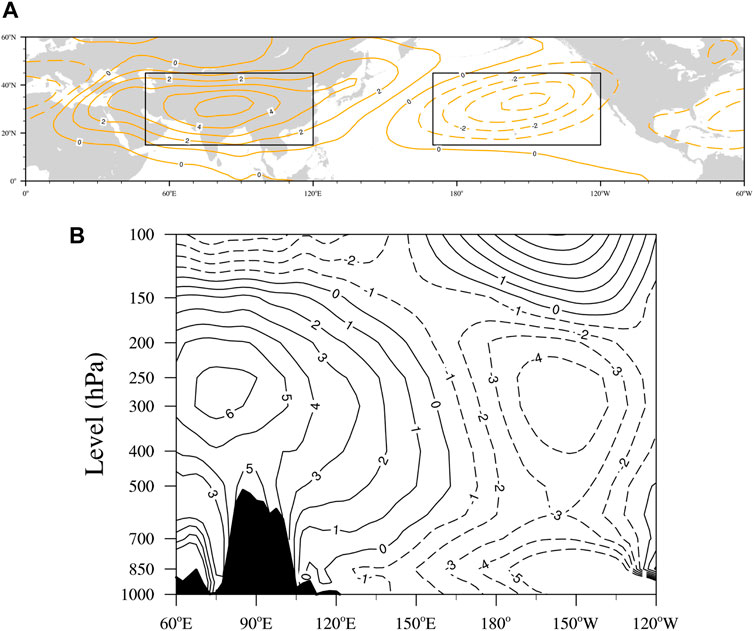
FIGURE 1. (A) Climatology (°C) of the August mean
According to Zhao et al. (2007), the arithmetic difference between the regional and vertical mean August
Results
August APO and September Precipitation Over Southeast China
Since the summer APO has a significant impact on simultaneous precipitation over China (Zhao et al., 2007), there is an important need to investigate whether September precipitation over China is associated with the preceding APO signals in the summer months. As depicted in Figures 2A–D, the August APO shows the largest and most significant correlation with the September precipitation anomalies over SC; therefore, we focus on exploring the impact of the August APO on September SC precipitation in the following analysis.
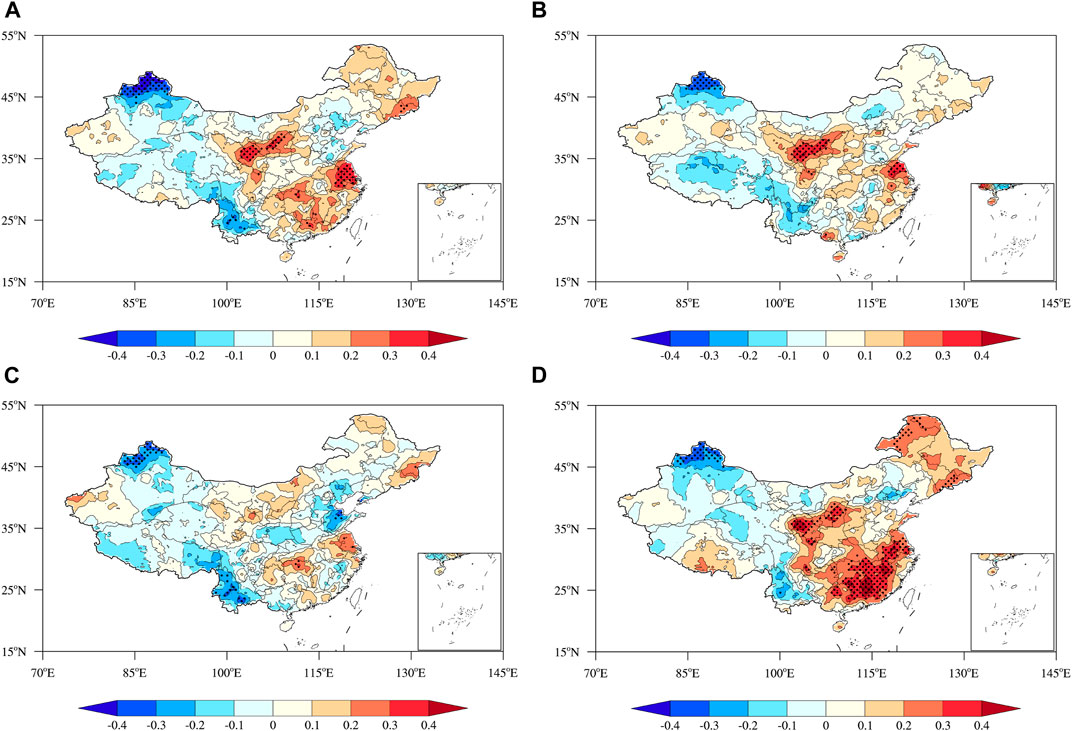
FIGURE 2. Correlation coefficients of the September precipitation anomalies over China and the (A) summer mean, (B) June, (C) July, and (D) August APOI. Stippled regions indicate statistical significance above the 95% confidence level.
The relationship between the August APOI (hereafter referred to as APOI) and precipitation anomalies over China in September after the removal of the ENSO signal is shown in Figure 3. It can be seen that when the ENSO signal is taken into account (Figure 2D), a significant positive correlation exists over SC (the central value exceeds 0.49), suggesting that more (less) September SC precipitation is probable in association with a stronger (weaker) August APO. Positive correlations are observed over SC, consistent with Figure 2D, but the region with significant positive correlation is slightly smaller (Figure 3). A comparison of Figure 2D with Figure 3 reveals that the significant positive correlation between the August APO and September SC precipitation is not significantly affected by ENSO. Regardless of whether the ENSO signal is removed, a significant positive correlation exists in the relationship between the August APO and September SC precipitation. Therefore, the main focus of the subsequent analysis is on the reasons for the relationship between August APO and September SC precipitation after the removal of the ENSO signal.

FIGURE 3. Correlation coefficients between the APOI and September precipitation anomalies over China after the removal of the ENSO signal (stippled regions indicate statistical significance above the 95% confidence level).
We further defined the Southeast China September precipitation index (SCPI) by averaging September SC precipitation from 24°N to 29°N and from 110°E to 118°E to investigate the impact of the August APO on September SC precipitation. The normalized SCPI and the APOI, displayed in Figure 4, show that the fluctuation of SCPI is significantly linked to the August APO with the correlation coefficient reaching 0.45, significant at the 99% confidence level, indicating their significant in-phase relationship.
We also defined extreme precipitation in September over SC with precipitation anomalies exceeding one standard deviation to examine the connection between September SC precipitation and the August APO. It can be seen in Figure 4 that there are 19 years with extremely precipitation throughout the analysis period, and the same sign rate between the SCPI and the APOI reached approximately 74% (it was 63% for the remaining 41 normal years), implying that the August APO might act as a potential predictor for both normal and extreme precipitation in September over SC.
Atmospheric Circulation Anomalies Linked to the August APO and September SC Precipitation
To further verify the relationship between the SCPI and the APOI, the August APO-induced atmospheric circulation anomalies were investigated. Figure 5 presents regressed SLP, 850 hPa wind field, 500 hPa geopotential height, 200 hPa meridional wind, and latitude–pressure section of the vertical circulation averaged along 110°–118°E against the SCPI and the APOI. It is evident from Figure 5A that negative SLP is located over Asia, while significant positive SLP is centered over the East China Sea and its adjacent region and the North Pacific. This spatial distribution will conduce to significantly anomalous lower-tropospheric southerlies over the East Asia coast. The regression pattern of geopotential height against the SCPI (Figure 5B) shows that significant negative (positive) geopotential height anomalies exist over the midlatitudes of Asia (the North Pacific), indicating that the strengthened (weakened) East Asian trough and North Pacific high are the likely causes of the observed increase (decrease) in September precipitation over SC. Furthermore, as shown in Figure 5C, the upper-level atmospheric circulation associated with increased September SC precipitation is characterized by significant anomalous southerlies (northerlies) over Northeast China (South China). This helps to enhance the divergence in the upper level over SC, thereby inducing a stronger trough over SC, and is conducive to anomalous upward motion. Moreover, the regressed vertical circulation (averaged along 110°–118°E) against the SCPI (Figure 5D) also shows anomalous southerlies with warm and humid air moving from lower latitudes toward SC, facilitating ascent and moisture convergence and thereby increasing precipitation over SC. It is important to note that the regressed patterns derived from the APOI (Figures 5E–H) are very similar to the patterns presented in Figures 5A–D, demonstrating that the August APO could be regarded as a crucial modulating factor of September SC precipitation through modification of the atmospheric circulation over the Asian–Pacific region.
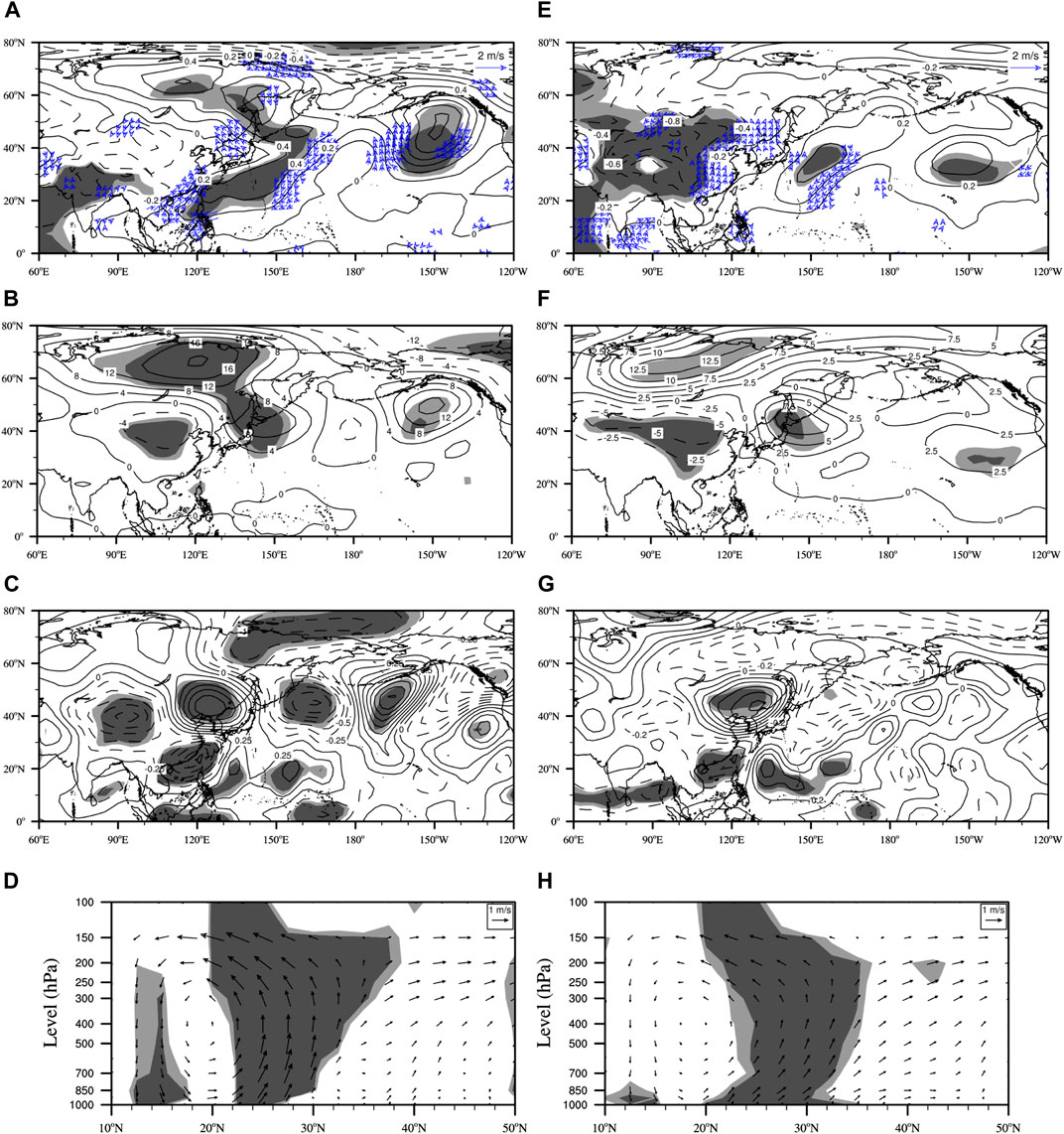
FIGURE 5. Regressed (A) SLP (unit: hPa; contours) and 850 hPa wind (unit: m s−1; vectors), (B) 500 hPa geopotential height (unit: m; contours), (C) 200 hPa meridional wind (unit: m s−1; contours), and (D) latitude–pressure section of 110°–118°E mean vertical circulation (unit: meridional wind ms−1, vertical velocity −0.01 Pa·s−1; vectors) against the SCPI, (E–H) same as (A–D) but for the APOI (dark (light) shadows represent the 95% (90%) confidence level).
Precipitation variation over the region is attributable mainly to strong moisture convergence and divergence associated with atmospheric circulation changes. Diagnosis of the climatological September vertically integrated moisture transport (Figure 6A) illustrates two chief channels of moisture flow toward SC: one originates from the Arabian Sea and the other from the Western Pacific. The regressed pattern of the SCPI onto moisture transport, shown in Figure 6B, reveals an anticyclonic circulation centered near the East China Sea and the western Pacific, which favors moisture transport toward SC. Moreover, the movement of moisture from the Arabian Sea toward SC is also reinforced. The alterations in water vapor transportation associated with the APO are illustrated in Figure 6C, in which the water vapor flux is regressed against the APOI. It can be seen that a strong August APO induces anomalous anticyclonic circulation over the western Pacific, which is close to the climatological distribution, thereby enhancing the transport of moisture from the western Pacific toward SC. Moreover, owing to the strengthening of the westerlies, the transport of moist air from the Arabian Sea increases the moisture flux toward SC. Consequently, the August APO could be expected to increase September SC precipitation by increasing the regional moisture availability.
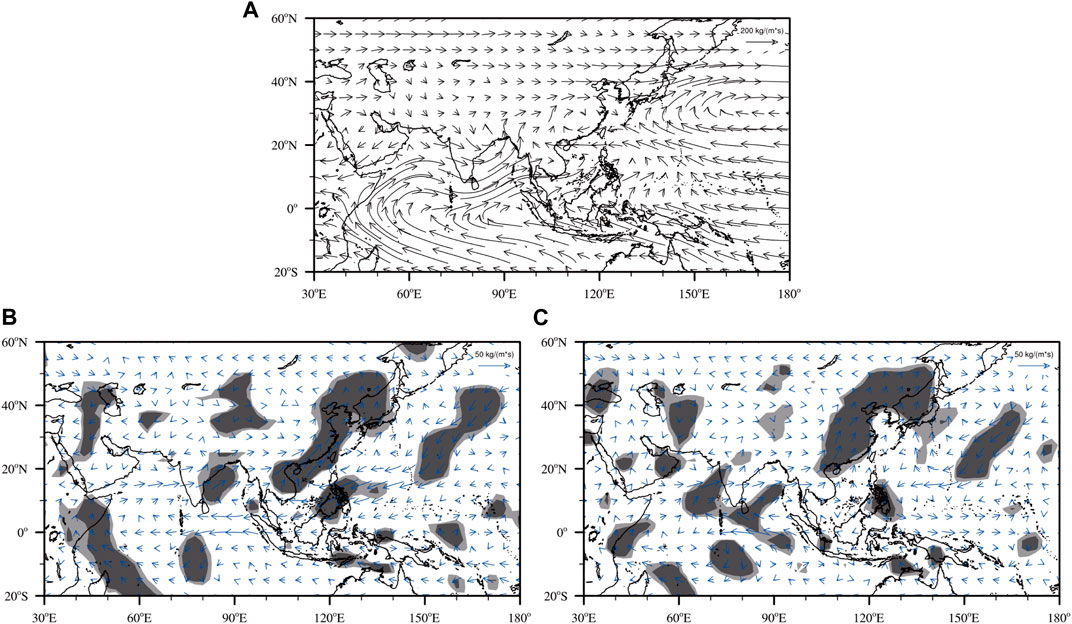
FIGURE 6. (A) Climatology of September vertically integrated moisture transport for 1961–2020 and regressed September vertically integrated moisture transport (unit: kg·m−1 s−1; vectors) onto (B) the SCPI and (C) the APOI (shading indicates areas significant at the 95% (dark) and 90% (light) confidence level).
Possible Mechanisms Linking the August APO to September SC Precipitation
The analyses above indicate that the preceding August APO could be regarded as an important indicator of September SC precipitation through later effects on the atmospheric circulation. This raises questions regarding the underlying atmospheric circulation variations behind the linkage between August APO and September SC precipitation. To tackle this issue, we analyzed the 500–200 hPa
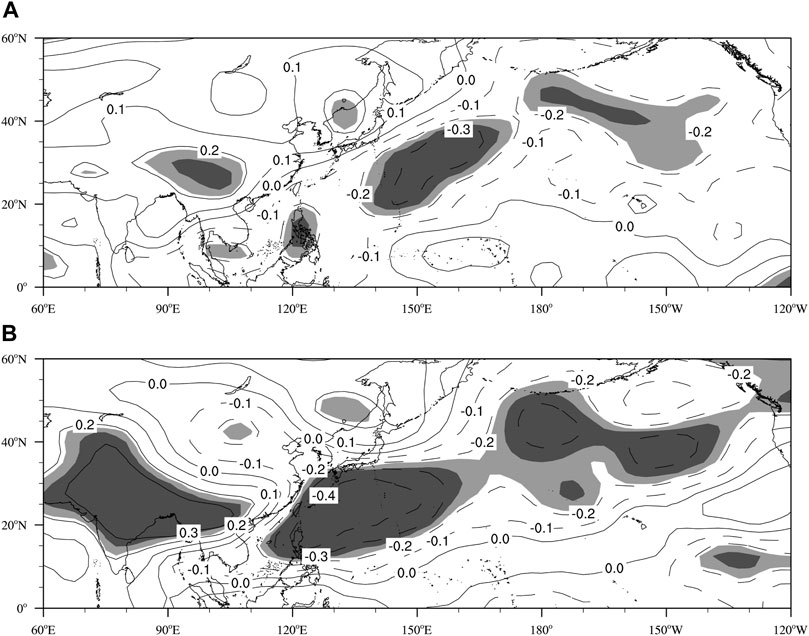
FIGURE 7. Correlation between the mean September 500–200 hPa
To address the atmospheric circulation changes behind the August APO–September SC precipitation relationship, we further calculated the regressed eddy geopotential height (
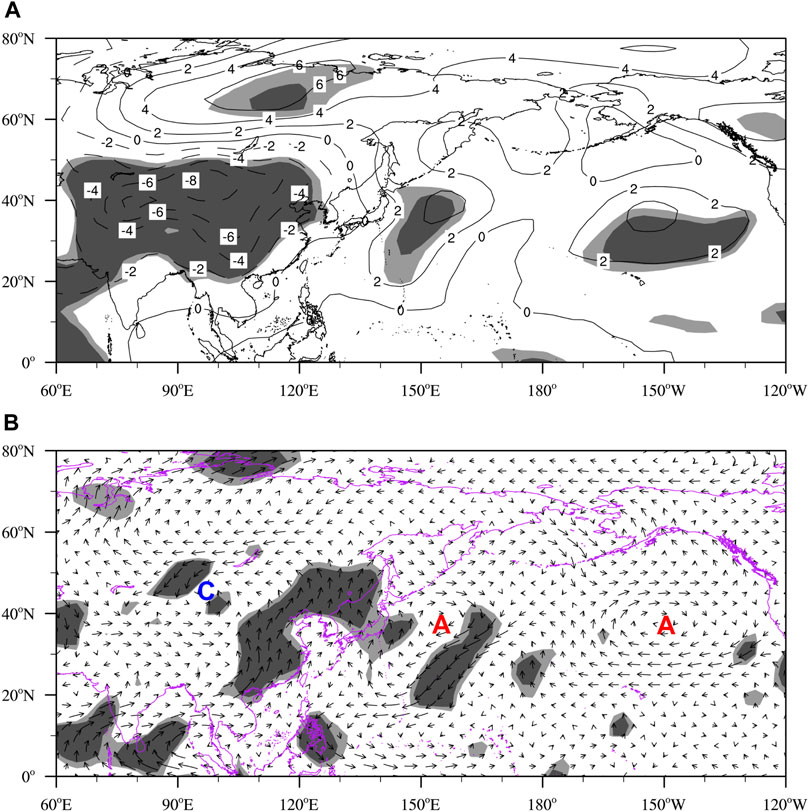
FIGURE 8. Regressed September 850 hPa (A)
To investigate the August APO-related atmospheric anomalies further, the regressed velocity potential and divergent winds at lower atmosphere (850 hPa) and vertical velocity against the APOI in September are displayed in Figure 9. From Figure 9A, it can be seen that the strengthened convergence wind with significant positive velocity potential over SC can strengthen ascending motion, leading to an increase in precipitation correspondingly. The same conclusions can be drawn as in vertical velocity that significant negative anomalies cover most areas of SC (Figure 9B), indicating a pronounced ascent motion over this region. This means the strengthened August APO caused the large ascent velocity and convection enhancement and consequently increases the precipitation in this area.

FIGURE 9. Regressed September (A) velocity potential (unit: 105 m2 s−1; contours) and divergent winds (unit: m s−1; vectors) at 850 hPa and (B) longitude–pressure section of 20°–40°N mean vertical velocity (unit: 0.01 Pa·s−1; contours) against the APOI for 1961–2020. Yellow (green) shading indicates the 95% (90%) confidence level. Topography with elevations higher than 1,500 m has been masked in (A).
Conclusions and Discussion
Using observations and reanalysis, this study investigated the linkage between the preceding August APO and following September SC precipitation during 1961–2020, and the underlying physical mechanisms were explored.
The correlation coefficient between the August APO and September SC precipitation was statistically significant, with a value of 0.45 that passed the 99% confidence level, indicating their pronounced in-phase relationship. Further analyses revealed that atmospheric circulation anomalies in September associated with the August APO are conducive to increasing September SC precipitation.
The intrinsic mechanism that gave rise to the linkage between the August APO and September SC precipitation was further investigated. The anomalous
This study analyzed the linkage between the August APO and September SC precipitation and proposed an underlying candidate mechanism, suggesting that, in addition to SST forcing, the temperature anomalies at the middle and upper troposphere may be regarded as a considerable precursory predictor. However, we mainly focus on the linkage between the APO and precipitation on the interannual time scale. Many studies reported that the interdecadal variations in precipitation over China are affected by multiple factors like atmospheric teleconnections and SST forcing (Huang et al., 2013; Ling Zhang et al., 2014; Yuan and Wang, 2019). Since the APO exhibits pronounced interannual and interdecadal variations (Zhao et al., 2007), a question arises: whether the interdecadal variation in the preceding or simultaneous APO can have an impact on the interdecadal autumn precipitation variation over China? In addition, the mechanism that governs the interaction between the APO and the East Asian climate is complex, and certain issues remain unclear. For instance, previous studies have revealed that the snow cover over the TP can have profound impacts on the simultaneous and subsequent precipitation over China (Liu et al., 2014; Zhang et al., 2021), and the APO was also found closely associated with the thermal condition of TP (Liu et al., 2017), so it is natural to question whether the TP snow can significantly influence the APO and further alter autumn precipitation over China? This is a topic that will require further discussion in the future.
Data Availability Statement
The raw data supporting the conclusions of this article will be made available by the authors, without undue reservation.
Author Contributions
Conceptualization and review and editing, WH. Project administration, WH and GF. Methodology and original draft preparation, CX. Software, CX, QH, JM, and XW. Investigation, GF. Data curation and formal analysis CX, JM, and XW. Visualization, QH and KY. Validation, KY. Supervision, GF. All authors have read and agreed to the published version of the manuscript.
Funding
This work was jointly supported by the Second Tibetan Plateau Scientific Expedition and Research (STEP) program (2019QZKK010203), the National Natural Science Foundation of China (42075019 and 41775072), the National Key Research and Development Program of China (2018YFC1505702), the Science and Technology Program of Sichuan province (2019JDJQ0001), and the Scientific Research Foundation of Chengdu University of Information Technology (KYTZ201812).
Conflict of Interest
The authors declare that the research was conducted in the absence of any commercial or financial relationships that could be construed as a potential conflict of interest.
Publisher’s Note
All claims expressed in this article are solely those of the authors and do not necessarily represent those of their affiliated organizations or those of the publisher, the editors, and the reviewers. Any product that may be evaluated in this article, or claim that may be made by its manufacturer, is not guaranteed or endorsed by the publisher.
References
An, S.-I. (2003). Conditional Maximum Covariance Analysis and its Application to the Tropical Indian Ocean SST and Surface Wind Stress Anomalies*. J. Clim. 16, 2932–2938. doi:10.1175/1520-0442(2003)016<2932:cmcaai>2.0.co;2
Barriopedro, D., Gouveia, C. M., Trigo, R. M., and Wang, L. (2012). The 2009/10 Drought in China: Possible Causes and Impacts on Vegetation. J. Hydrometeorol. 13, 1251–1267. doi:10.1175/jhm-d-11-074.1
Hu, P., Chen, W., Chen, S., Liu, Y., Wang, L., and Huang, R. (2020). Impact of the September Silk Road Pattern on the South China Sea Summer Monsoon Withdrawal. Int. J. Climatol. 40, 6361–6368. doi:10.1002/joc.6585
Hua, W., Lin, Z., Wang, X., and Fan, G. (2019). Weakening Relationship between East Asian Summer Monsoon and Asian-Pacific Oscillation after 1990s. Adv. Meteorology 2019, 1–9. doi:10.1155/2019/6012301
Huang, R., Liu, Y., and Feng, T. (2013). Interdecadal Change of Summer Precipitation over Eastern China Around the Late-1990s and Associated Circulation Anomalies, Internal Dynamical Causes. Chin. Sci. Bull. 58, 1339–1349. doi:10.1007/s11434-012-5545-9
Kalnay, E., Kanamitsu, M., Kistler, R., Collins, W., Deaven, D., Gandin, L., et al. (1996). The NCEP/NCAR 40-year Reanalysis Project. Bull. Amer. Meteor. Soc. 77, 437–471. doi:10.1175/1520-0477(1996)077<0437:tnyrp>2.0.co;2
Li, W., Zuo, J., Song, Y., Liu, J., Li, Y., Shen, Y., et al. (2015). Changes in Spatio-Temporal Distribution/Flood Disaster in Southern China under Global Climate Warming (In Chinese). Meteorol. Mon. 41, 261–271. doi:10.7519/j.issn.1000-0526.2015.03.001
Lin, Z., Zhu, J., Hua, W., and Fan, G. (2019). Influence of Asian-Pacific Oscillation on Precipitation in Central Eastern China during Autumn (1960–2016). Adv. Meteorology 2019, 1–10. doi:10.1155/2019/1376980
Lin, Z., Zhu, J., Hua, W., and Fan, G. (2021). Impact of the August Asian-Pacific Oscillation on Autumn Precipitation in Central Eastern China. Asia-Pacific J. Atmos. Sci. 57, 181–190. doi:10.1007/s13143-020-00187-1
Ling Zhang, L., Zhu, X., Fraedrich, K., Sielmann, F., and Zhi, X. (2014). Interdecadal Variability of Winter Precipitation in Southeast China. Clim. Dyn. 43, 2239–2248. doi:10.1007/s00382-014-2048-1
Liu, G., Zhao, P., and Chen, J. (2011). A 150-year Reconstructed Summer Asian-Pacific Oscillation Index and its Association with Precipitation over Eastern China. Theor. Appl. Climatol. 103, 239–248. doi:10.1007/s00704-010-0294-7
Liu, G., Wu, R., Zhang, Y., and Nan, S. (2014). The Summer Snow Cover Anomaly over the Tibetan Plateau and its Association with Simultaneous Precipitation over the Mei-Yu-Baiu Region. Adv. Atmos. Sci. 31, 755–764. doi:10.1007/s00376-013-3183-z
Liu, G., Zhao, P., and Chen, J. (2017). Possible Effect of the Thermal Condition of the Tibetan Plateau on the Interannual Variability of the Summer Asian-Pacific Oscillation. J. Clim. 30, 9965–9977. doi:10.1175/jcli-d-17-0079.1
Liu, Z., and Zhou, W. (2021). The 2019 Autumn Hot Drought over the Middle‐Lower Reaches of the Yangtze River in China: Early Propagation, Process Evolution, and Concurrence. J. Geophys. Res. Atmos. 126, e2020JD033742. doi:10.1029/2020jd033742
Lorenz, E. N. (1956). Empirical Orthogonal Functions and Statistical Weather Prediction. Scientific Report No. 1. Department of Meteorology, MIT. (NTIS AD 110268).
Niu, N., and Li, J. (2008). Interannual Variability of Autumn Precipitation over South China and its Relation to Atmospheric Circulation and SST Anomalies. Adv. Atmos. Sci. 25, 117–125. doi:10.1007/s00376-008-0117-2
Qiang Zhang, Q., Li, J., Singh, V. P., Xu, C.-Y., and Deng, J. (2013). Influence of ENSO on Precipitation in the East River Basin, South China. J. Geophys. Res. Atmos. 118, 2207–2219. doi:10.1002/jgrd.50279
Wenjun Zhang, W., Jin, F.-F., Zhao, J.-X., Qi, L., and Ren, H.-L. (2013). The Possible Influence of a Nonconventional El Niño on the Severe Autumn Drought of 2009 in Southwest China. J. Clim. 26, 8392–8405. doi:10.1175/JCLI-D-12-00851.1
Wenjun Zhang, W., Jin, F.-F., and Turner, A. (2014). Increasing Autumn Drought over Southern China Associated with ENSO Regime Shift. Geophys. Res. Lett. 41, 4020–4026. doi:10.1002/2014GL060130
Wu, J., and Gao, X. (2013). A Gridded Daily Observation Dataset over China Region and Comparison with the Other Datasets (In Chinese). Chin. J. Geophys. 56, 1102–1111. doi:10.6038/cjg20130406
Xiao, M., Zhang, Q., and Singh, V. P. (2015). Influences of ENSO, NAO, IOD and PDO on Seasonal Precipitation Regimes in the Yangtze River Basin, China. Int. J. Climatol. 35, 3556–3567. doi:10.1002/joc.4228
Xu, H., Feng, J., and Sun, C. (2013). Impact of Preceding Summer North Atlantic Oscillation on Early Autumn Precipitation over Central China. Atmos. Ocean. Sci. Lett. 6, 417–422. doi:10.3878/j.issn.1674-2834.13.0027
Yang, M., and Chen, L. (2021). Features and Possible Causes of Abnormal Climate over China in Autumn 2020 (In Chinese). Meteorol. Mon. 47, 499–509. doi:10.7519/j.issn.1000-0526.2021.04.011
Yuan, C., and Wang, D. (2019). Inter‐decadal Variations in El Niño-Southern Oscillation Impacts on the Autumn Precipitation in the Eastern China. Int. J. Climatol. 39, 5316–5326. doi:10.1002/joc.6156
Zhang, R., Sumi, A., and Kimoto, M. (1999). A Diagnostic Study of the Impact of El Niño on the Precipitation in China. Adv. Atmos. Sci. 16, 229–241. doi:10.1007/BF02973084
Zhang, G., Zeng, G., Ni, D., and Zhou, G. (2016). Decadal Shift of Autumn Drought in Southwest China and its Possible Causes (In Chinese). Chin. J. Atmos. Sci. 40, 311–323. doi:10.1088/1674-1137/40/8/081001
Zhang, C., Jia, X., and Wen, Z. (2021). Increased Impact of the Tibetan Plateau Spring Snow Cover to the Mei-Yu Rainfall over the Yangtze River Valley after the 1990s. J. Clim. 34, 5985–5997. doi:10.1175/JCLI-D-21-0009.1
Zhao, P., Zhu, Y., and Zhang, R. (2007). An Asian-Pacific Teleconnection in Summer Tropospheric Temperature and Associated Asian Climate Variability. Clim. Dyn. 29, 293–303. doi:10.1007/s00382-007-0236-y
Zhao, P., Cao, Z., and Chen, J. (2010). A Summer Teleconnection Pattern over the Extratropical Northern Hemisphere and Associated Mechanisms. Clim. Dyn. 35, 523–534. doi:10.1007/s00382-009-0699-0
Zhao, P., Yang, S., Jian, M., and Chen, J. (2011). Relative Controls of Asian-Pacific Summer Climate by Asian Land and Tropical-North Pacific Sea Surface Temperature. J. Clim. 24, 4165–4188. doi:10.1175/2011JCLI3915.1
Zhao, P., Wang, B., and Zhou, X. (2012a). Boreal Summer Continental Monsoon Rainfall and Hydroclimate Anomalies Associated with the Asian-Pacific Oscillation. Clim. Dyn. 39, 1197–1207. doi:10.1007/s00382-012-1348-6
Zhao, P., Yang, S., Wu, R., Wen, Z., Chen, J., and Wang, H. (2012b). Asian Origin of Interannual Variations of Summer Climate over the Extratropical North Atlantic Ocean. J. Clim. 25, 6594–6609. doi:10.1175/JCLI-D-11-00617.1
Zhou, B., Cui, X., and Zhao, P. (2008). Relationship between the Asian-Pacific Oscillation and the Tropical Cyclone Frequency in the Western North Pacific. Sci. China Ser. D-Earth Sci. 51, 380–385. doi:10.1007/s11430-008-0014-7
Zhou, X., Zhao, P., and Liu, G. (2009). Asian-Pacific Oscillation Index and Variation of East Asian Summer Monsoon over the Past Millennium. Chin. Sci. Bull. 54, 3768–3771. doi:10.1007/s11434-009-0619-z
Zhou, B., Zhao, P., and Cui, X. (2010). Linkage between the Asian-Pacific Oscillation and the Sea Surface Temperature in the North Pacific. Chin. Sci. Bull. 55, 1193–1198. doi:10.1007/s11434-009-0386-x
Zhou, B., Xu, M., Sun, B., Han, T., and Cheng, Z. (2021). Possible Role of Southern Hemispheric Sea Ice in the Variability of West China Autumn Rain. Atmos. Res. 249, 105329. doi:10.1016/j.atmosres.2020.105329
Zhou, B., and Zhao, P. (2010). Influence of the Asian-Pacific Oscillation on Spring Precipitation over Central Eastern China. Adv. Atmos. Sci. 27, 575–582. doi:10.1007/s00376-009-9058-7
Zhou, P., Yang, S., Jian, M., and Chen, J. (2011). Relative Controls of Asian-Pacific Summer Climate by Asian Land and Tropical-North Pacific Sea Surface Temperature. J. Clim. 24, 4165–4188. doi:10.1175/2011JCLI3915.1
Zou, Y., Zhao, P., and Lin, Q. (2015). Asian–Pacific Oscillation in Autumn and its Relationships with the Subtropical Monsoon in East Asia. J. Trop. Meteorology 21, 143–152. doi:10.16555/j.1006-8775.2015.02.005
Keywords: Asian–Pacific oscillation, tropospheric temperature, precursory signal, Southeast China, precipitation
Citation: Xia C, Hua W, Hu Q, Yang K, Ming J, Wu X and Fan G (2022) Linkage Between Preceding August Asian–Pacific Oscillation and September Precipitation Over Southeast China. Front. Earth Sci. 10:917445. doi: 10.3389/feart.2022.917445
Received: 11 April 2022; Accepted: 25 April 2022;
Published: 25 May 2022.
Edited by:
Jingyu Wang, Nanyang Technological University, SingaporeReviewed by:
Bo Sun, Nanjing University of Information Science and Technology, ChinaHuopo Chen, Institute of Atmospheric Physics (CAS), China
Copyright © 2022 Xia, Hua, Hu, Yang, Ming, Wu and Fan. This is an open-access article distributed under the terms of the Creative Commons Attribution License (CC BY). The use, distribution or reproduction in other forums is permitted, provided the original author(s) and the copyright owner(s) are credited and that the original publication in this journal is cited, in accordance with accepted academic practice. No use, distribution or reproduction is permitted which does not comply with these terms.
*Correspondence: Qin Hu, aHFAY3VpdC5lZHUuY24=; Wei Hua, aHVhd2VpQGN1aXQuZWR1LmNu
 Changji Xia
Changji Xia Wei Hua
Wei Hua Qin Hu
Qin Hu Kaiqing Yang1
Kaiqing Yang1